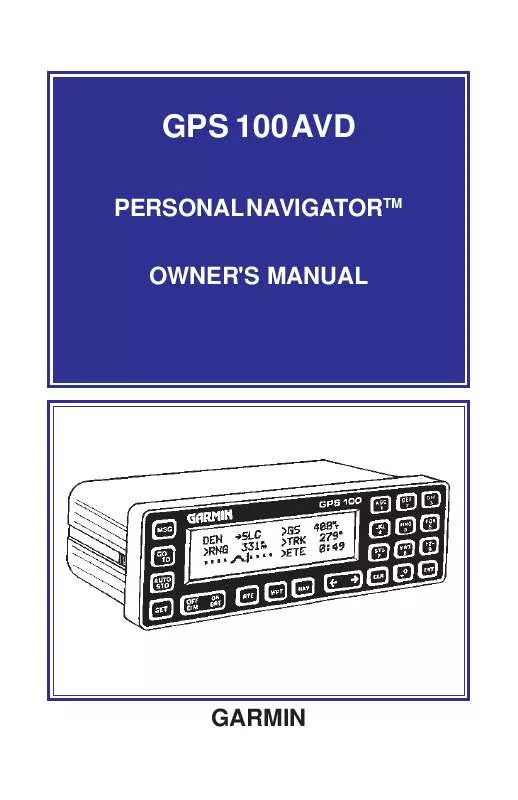User manual GARMIN GPS 100 AVD
Lastmanuals offers a socially driven service of sharing, storing and searching manuals related to use of hardware and software : user guide, owner's manual, quick start guide, technical datasheets... DON'T FORGET : ALWAYS READ THE USER GUIDE BEFORE BUYING !!!
If this document matches the user guide, instructions manual or user manual, feature sets, schematics you are looking for, download it now. Lastmanuals provides you a fast and easy access to the user manual GARMIN GPS 100 AVD. We hope that this GARMIN GPS 100 AVD user guide will be useful to you.
Lastmanuals help download the user guide GARMIN GPS 100 AVD.
Manual abstract: user guide GARMIN GPS 100 AVD
Detailed instructions for use are in the User's Guide.
[. . . ] GPS 100 AVD
PERSONAL NAVIGATORTM OWNER'S MANUAL
GARMIN
GPS 100 AVD
Personal NavigatorTM
OWNER'S MANUAL
© 1992 GARMIN, 9875 Widmer Road, Lenexa, KS 66215 Printed in Taiwan. No part of this manual may be reproduced or transmitted in any form or by any means, electronic or mechanical, including photocopying and recording, for any purpose without the express written permission of GARMIN. Information in this document is subject to change without notice. GARMIN reserves the right to change or improve their products and to make changes in the content without obligation to notify any person or organization of such changes or improvements. [. . . ] You may enter a different speed to calculate time requirements.
The GPS 100 will display the distance and bearing between the two geographical points. In addition, the time requirement will be displayed based on speed. Use the cyclic field to select estimated time enroute (ETE) or estimated time of arrival (ETA). To perform trip planning for a programmed route. . .
·
Use the CLR key to select the desired route as illustrated below. (The waypoint/route selection field will cycle through all programmed routes containing 2 or more waypoints, i. e. , RT0 to RT9. ) Total/Leg Selection
·
The first and last waypoints, total distance, and ETA/ETE information will be displayed for the entire route, as indicated by "TTL". To display the distance, bearing, and ETA/ETE information for each individual leg, use the CLR key to change from "TTL" to the desired leg. (The leg field will cycle through every programmed leg, i. e. , LG1 to LG8, and the route total, TTL. )
·
9. 2 FUEL PLANNING
Waypoint/Route Selection From Waypoint To Waypoint
Speed Fuel Flow
Time Fuel Required
FUEL PLANNING PAGE
The Fuel Planning Page allows you to calculate fuel requirements for any route you have programmed or between any two waypoints.
9-2
To calculate the fuel requirements between two waypoints. . . · · Use the CLR key to select "WPT" on line 1. If you wish to use your present location, leave it blank. If you wish to use your present location, leave it blank. The speed field will display your present speed. You may enter a different speed to calculate time and fuel requirements. Enter the fuel flow in units per hour (e. g. , gallons per hour. )
·
·
·
The GPS 100 will calculate fuel requirements in the corresponding units (e. g. , gallons) required to go from point 1 to point 2. In addition, the time requirement will be displayed based on speed. Use the cyclic field to select estimated time enroute (ETE) or estimated time of arrival (ETA). You may calculate the fuel required for a programmed route in a manner similar to the trip planning described in Section 9. 1. 9. 3 DENSITY ALTITUDE/TAS
Indicated Altitude Altimeter Setting Calibrated Airspeed Total Air Temperature
Density Altitude
True Airspeed
DENSITY ALTITUDE/TAS PAGE The Density Altitude/TAS function will help you calculate critical aircraft performance data. To calculate density altitude and true airspeed. . . · Enter the indicated altitude from your altimeter.
9-3
·
Enter your calibrated airspeed. If you do not know your calibrated airspeed, use indicated airspeed instead. TAT is the temperature of the air including the heating effect caused by speed (the temperature read on a standard outside air temperature gauge found on most piston aircraft is TAT). The GPS 100 will display the resulting density altitude and true airspeed.
· ·
The TAS computed on this page will automatically become the default value used in the wind aloft calculations described in the following section. [. . . ] Errors in range measurements may result in disproportionately larger errors in position depending on the geometry of the satellites being used for navigation.
A-1
When all GPS satellites have been deployed, 3D coverage with good geometry will be available 24 hours a day worldwide. Until then, there may be periods of time when only 2D coverage is available with occasional outages in coverage. A. 3 GPS RECEIVER DESIGNS Until now, most GPS receiver designs could be categorized as one of three types: · Continuous Receiverstypically consist of five or more channels with each channel dedicated to the tracking of one satellite. Receivers with this design provide the highest performance but are also large, expensive, and consume more power. [. . . ]
DISCLAIMER TO DOWNLOAD THE USER GUIDE GARMIN GPS 100 AVD Lastmanuals offers a socially driven service of sharing, storing and searching manuals related to use of hardware and software : user guide, owner's manual, quick start guide, technical datasheets...manual GARMIN GPS 100 AVD


